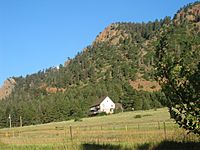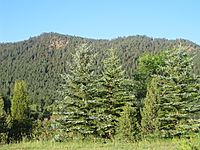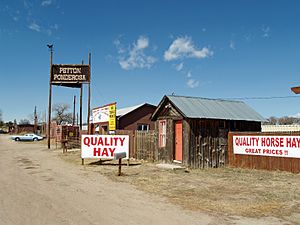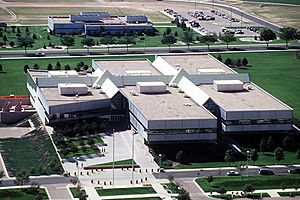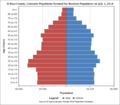El Paso County, Colorado facts for kids
Quick facts for kids
El Paso County
|
|
|---|---|
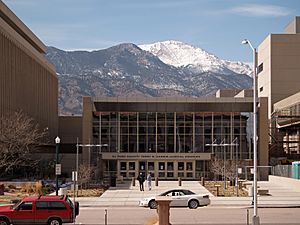
El Paso County Justice Center
|
|
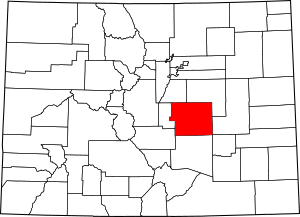
Location within the U.S. state of Colorado
|
|
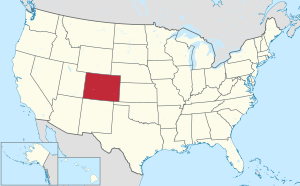 Colorado's location within the U.S. |
|
| Country | |
| State | |
| Founded | November 1, 1861 |
| Named for | Spanish-language name for Ute Pass |
| Seat | Colorado Springs |
| Largest city | Colorado Springs |
| Area | |
| • Total | 2,130 sq mi (5,500 km2) |
| • Land | 2,127 sq mi (5,510 km2) |
| • Water | 2.7 sq mi (7 km2) 0.1%% |
| Population | |
| • Estimate
(2015)
|
674,471 |
| • Density | 293/sq mi (113/km2) |
| Time zone | UTC−7 (Mountain) |
| • Summer (DST) | UTC−6 (MDT) |
| Congressional district | 5th |
|
|
|
El Paso County is one of the 64 counties of the U.S. state of Colorado. The 2014 Census] recorded a population of 663,519 for El Paso County. The Census Bureau's 2014 estimate indicates it is the second most populous county in Colorado, after the City and County of Denver. The county seat is Colorado Springs, the second most populous city in Colorado.
El Paso County is included in the Colorado Springs, CO Metropolitan Statistical Area.
El Paso County is located in Colorado's 5th congressional district. Since its creation in 1871, El Paso County has typically voted for the Republican presidential candidate in presidential elections; the last Democratic nominee to win the county was Lyndon B. Johnson in 1964. The Democratic Party won El Paso County four additional times prior, and the Populist Party won in 1892, with General James B. Weaver.
History
In July 1858, gold was discovered along the South Platte River in Arapahoe County, Kansas Territory. This discovery precipitated the Pike's Peak Gold Rush. Many residents of the mining region felt disconnected from the remote territorial governments of Kansas and Nebraska, so they voted to form their own Territory of Jefferson on October 24, 1859. The following month, the Jefferson Territorial Legislature organized 12 counties for the new territory including El Paso County. El Paso County was named for the Spanish language name for Ute Pass north of Pikes Peak. Colorado City served as the county seat of El Paso County.
The Jefferson Territory never received federal sanction, but on February 28, 1861, U.S. President James Buchanan signed an act organizing the Territory of Colorado. El Paso County was one of the original 17 counties created by the Colorado legislature on November 1, 1861. Part of its western territory was broken off to create Teller County in 1899. Originally based in Old Colorado City (now part of Colorado Springs, not today's Colorado City between Pueblo and Walsenburg), El Paso County's county seat was moved to Colorado Springs in 1873.
Geography
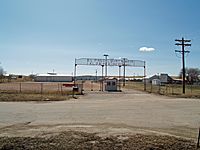
According to the U.S. Census Bureau, the county has a total area of 2,130 square miles (5,500 km2), of which 2,127 square miles (5,510 km2) is land and 2.7 square miles (7.0 km2) (0.1%) is water.
Adjacent counties
- Douglas County - north
- Elbert County - northeast
- Lincoln County - east
- Crowley County - southeast
- Pueblo County - south
- Fremont County - west
- Teller County - west
Major highways
 Interstate 25
Interstate 25 U.S. Highway 24
U.S. Highway 24 U.S. Highway 85
U.S. Highway 85 State Highway 83
State Highway 83 State Highway 94
State Highway 94 State Highway 115
State Highway 115
National protected area

- Pike National Forest
State protected area
Historic sites
- Pikes Peak National Historic Landmark
- USAFA Cadet Area National Historic District
- Old Colorado City (National Register of Historic Districts)
- Manitou Springs (National Register of Historic Districts)
Trails
- American Discovery Trail
- Barr National Recreation Trail
- Bear Creek Cañon Park
- Bear Creek Regional Park and Nature Center
- Calhan Paint Mines
- Fountain Creek Nature Center
- The Incline
- New Santa Fe Trail
- Pikes Peak Greenway
- White House Ranch National Recreation Trail
Demographics
| Historical population | |||
|---|---|---|---|
| Census | Pop. | %± | |
| 1870 | 987 | — | |
| 1880 | 7,949 | 705.4% | |
| 1890 | 21,239 | 167.2% | |
| 1900 | 31,602 | 48.8% | |
| 1910 | 43,321 | 37.1% | |
| 1920 | 44,027 | 1.6% | |
| 1930 | 49,570 | 12.6% | |
| 1940 | 54,025 | 9.0% | |
| 1950 | 74,523 | 37.9% | |
| 1960 | 143,742 | 92.9% | |
| 1970 | 235,972 | 64.2% | |
| 1980 | 309,424 | 31.1% | |
| 1990 | 397,014 | 28.3% | |
| 2000 | 516,929 | 30.2% | |
| 2010 | 622,263 | 20.4% | |
| 2015 (est.) | 674,471 | 8.4% | |
| U.S. Decennial Census 1790-1960 1900-1990 1990-2000 2010-2015 |
|||
As of the census of 2000, there were 516,929 people, 192,409 households, and 133,916 families residing in the county. The population density was 243 people per square mile (94/km²). There were 202,428 housing units at an average density of 95 per square mile (37/km²). The racial makeup of the county was 81.19% White, 6.51% Black or African American, 0.91% Native American, 2.53% Asian, 0.24% Pacific Islander, 4.70% from other races, and 3.91% from two or more races. 11.30% of the population were Hispanic or Latino of any race.
There were 192,409 households out of which 36.70% had children under the age of 18 living with them, 55.60% were married couples living together, 10.20% had a female householder with no husband present, and 30.40% were non-families. 23.90% of all households were made up of individuals and 6.10% had someone living alone who was 65 years of age or older. The average household size was 2.61 and the average family size was 3.11.
In the county, the population was spread out with 27.60% under the age of 18, 10.50% from 18 to 24, 32.50% from 25 to 44, 20.70% from 45 to 64, and 8.70% who were 65 years of age or older. The median age was 33 years. For every 100 females there were 100.90 males. For every 100 females age 18 and over, there were 98.80 males.
Communities
Cities
Towns
- Calhan
- Green Mountain Falls
- Monument
- Palmer Lake
- Ramah
Census-designated places
- Air Force Academy
- Black Forest
- Cascade-Chipita Park
- Cimarron Hills
- Ellicott
- Fort Carson
- Gleneagle
- Peyton
- Rock Creek Park
- Security-Widefield
- Stratmoor
- Woodmoor
Other unincorporated communities
Military installations
Colorado Springs is home to both Army and Air Force bases. These military installations border the city, to the north, south and east, aside from Schriever Air Force Base, which is located farther east of the city, still in El Paso County.
Fort Carson
Fort Carson, “The Mountain Post”, is located just south of Colorado Springs at the base of the Rocky Mountains. It was established in 1942, following Japan’s attack on Pearl Harbor. The city of Colorado Springs purchased land south of the city and donated it to the War Department. Construction began immediately and the first building, the camp headquarters, was completed Jan. 31, 1942. Camp Carson was named in honor of the legendary Army scout, Gen. Christopher “Kit” Carson, who explored much of the West in the 1800s. Camp Carson became Fort Carson in 1954. An additional training area was purchased in September 1983 and is called Piñon Canyon Maneuver Site (PCMS).
Currently, Fort Carson is the home of 4th Infantry Division and several other units, including 10th Special Forces Group (Airborne), the Colorado National Guard Regional Training Institute and PCMS, which is a maneuver training site for Fort Carson located near Trinidad, Colorado. The installation totals approximately 137,000 acres and PCMS is approximately 236,000 acres. Fort Carson has approximately 3,000 family housing units and 66 Soldier barracks with 8,132 rooms. Services on the installation include four elementary schools, one middle school, commissary, an Exchange, and Evans Army Community Hospital as well as Army Community Service facilities to include child development centers and youth centers and Family Morale, Welfare and Recreation facilities to include a bowling alley, golf course and numerous parks.
Fort Carson’s economic impact on Colorado Springs and the surrounding communities was approximately $2.3 billion during fiscal year 2014. Fort Carson has approximately 24,300 Soldiers on the installation to include 44,700 family members. The installation also has approximately 8,000 veterans and 3,300 civilians.
Peterson Air Force Base
The Air Force has critical aspects of their service based at Colorado Springs which carry on missile defense operations and development. The Air Force bases a large section of its national missile defense operations here, with Peterson Air Force Base set to operate large sections of the program. Peterson AFB is currently the headquarters of the majority of Air Force Space Command and the operations half of Army Space and Missile Defense Command/Army Strategic Command (SMDC/ARSTRAT).
Peterson is also headquarters for the United States Northern Command (USNORTHCOM), one of the Unified Combatant Commands. USNORTHCOM directs all branches of the U.S. military operations in their area of responsibility which includes the continental United States, Alaska, Canada, and Mexico. In the event of national emergencies the President or Secretary of Defense can call upon USNORTHCOM for any required military assistance. Service members from every branch of the US Military are stationed at the command.
Schriever Air Force Base (formerly Falcon AFB)
Schriever Air Force Base is home to the 50th Space Wing, responsible for the operation and support of 175 Department of Defense satellites and installation support to 16 major tenant units with a workforce of more than 7,700 personnel. It is the location of the Global Positioning System (GPS) master control station and GPS Operations Center and the US Naval Observatory Alternate Master Clock, used to synchronize GPS satellite time. Schriever is also developing parts of national missile defense and runs parts of the annual wargames used by the nation's military. The base indirectly contributes an estimated $1 billion to the local Colorado Springs, CO area annually.
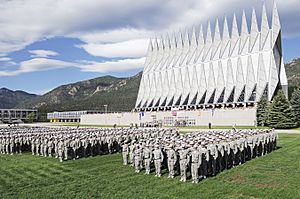
United States Air Force Academy
Bordering the north-western side of the city are the vast grounds of the United States Air Force Academy, where cadets train to become officers in the Air Force. The campus is famous for its unique chapel and draws visitors year round. Most of the Air Force Academy's sports programs participate in the Mountain West Conference.
NORAD and Cheyenne Mountain Air Station
The North American Aerospace Defense Command (NORAD), a component of America's missile defense system, is located in Cheyenne Mountain Air Station. When it was built at the height of the Cold War, NORAD caused some anxiety for the residents in and around Colorado Springs, who believed the installation would be a primary target during a nuclear attack. Although NORAD still operates today, it is primarily tasked with the tracking of ICBMs, and the military has recently decided to place Cheyenne Mountain's NORAD/NORTHCOM operations on warm standby and move operations to nearby Peterson Air Force Base.
Images for kids
See also
 In Spanish: Condado de El Paso (Colorado) para niños
In Spanish: Condado de El Paso (Colorado) para niños


